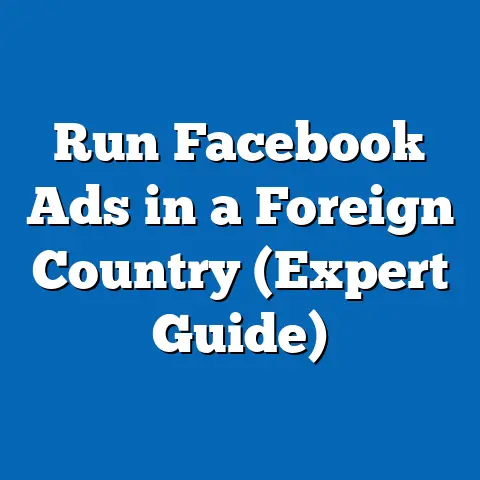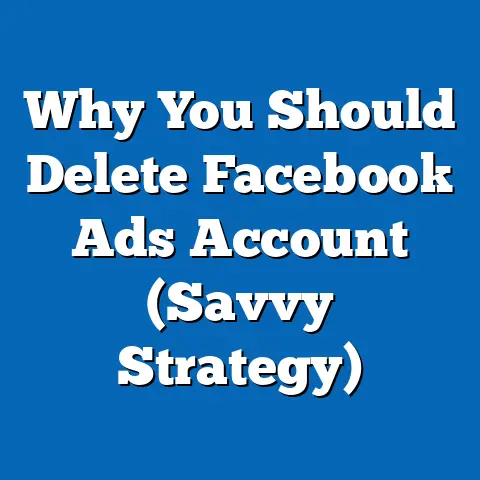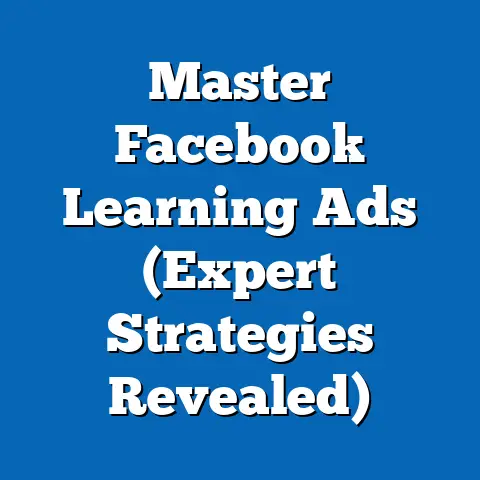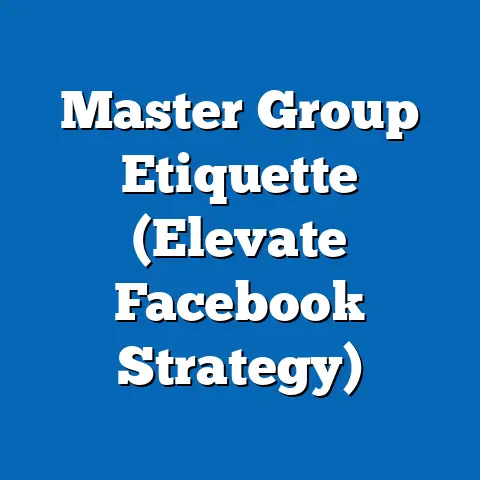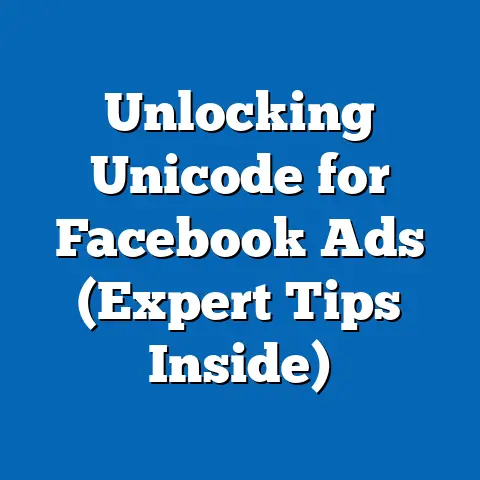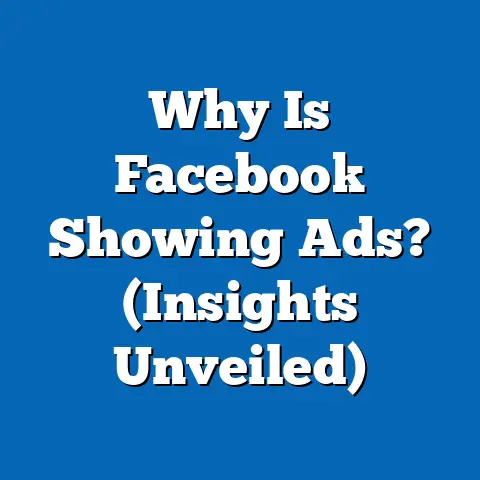Master Facebook Ads Interests (Unleash Targeted Engagement)
Facebook Ads have become an indispensable tool for businesses seeking to expand their reach and connect with potential customers. In my years of experience in digital marketing, I’ve seen countless marketers searching for that “set it and forget it” solution – a low-maintenance approach that still delivers impressive results. While there’s no magic bullet, mastering Facebook Ads interests comes pretty darn close. It’s about understanding how to tap into the passions, hobbies, and preferences of your target audience to create ads that resonate and drive meaningful engagement.
Think of it like this: instead of casting a wide net and hoping to catch a few relevant fish, you’re using a finely tuned sonar to pinpoint exactly where your ideal customers are swimming. By understanding and leveraging Facebook Ads interests, you can achieve remarkable engagement with minimal ongoing effort, making your advertising campaigns both efficient and effective.
The Importance of Targeted Engagement
In today’s fiercely competitive digital landscape, simply throwing money at ads and hoping for the best is a recipe for disaster. Consumers are bombarded with marketing messages from all directions, and they’ve become incredibly adept at tuning out anything that doesn’t feel relevant. That’s where targeted engagement comes in. It’s about delivering the right message, to the right people, at the right time.
Targeted engagement, fueled by a deep understanding of Facebook Ads interests, can dramatically improve your ad relevance. When your ads align with the specific interests of your audience, they’re far more likely to pay attention, click through, and ultimately convert into customers. This enhanced audience targeting translates directly into higher conversion rates and a significantly improved return on ad spend (ROAS).
I’ve seen this play out time and time again. For instance, I worked with a local bookstore that was struggling to attract new customers. After diving into their target audience’s interests – things like “literary fiction,” “book clubs,” and “local authors” – we crafted ad campaigns that spoke directly to their passions. The result? A 30% increase in click-through rates and a 20% boost in in-store sales within just a few months. This real-world example underscores the power of understanding and leveraging interests to drive meaningful results.
According to recent industry reports, ads that utilize interest-based targeting have a 2x higher CTR compared to those that don’t. Furthermore, businesses that invest in targeted engagement strategies see an average of 3x higher ROAS. These statistics highlight the undeniable value of focusing on targeted engagement and the role that Facebook Ads interests play in achieving it.
Key Takeaway: Targeted engagement is paramount in today’s digital landscape. By understanding and leveraging Facebook Ads interests, you can improve ad relevance, enhance audience targeting, and drive higher conversion rates, ultimately leading to a better ROAS.
Understanding Facebook Ads Interests
So, what exactly are Facebook Ads interests, and how do they work within the Facebook Ads ecosystem? In simple terms, interests are categories and topics that Facebook uses to classify its users based on their behavior and preferences. These interests are derived from a multitude of data points, including the pages users like, the groups they join, the content they engage with, and even the apps they use.
Think of it as a complex web of connections that paints a comprehensive picture of each user’s digital identity. Facebook then uses this information to create a vast database of interests that advertisers can tap into.
There are two primary types of interests available for targeting:
- Broad Categories: These are general interests that encompass a wide range of users, such as “sports,” “music,” or “fashion.” While broad categories can be useful for reaching a large audience, they often lack the specificity needed to drive targeted engagement.
- Niche Interests: These are more specific and targeted interests that cater to smaller, more defined groups of users. Examples include “vintage guitars,” “organic gardening,” or “sustainable fashion.” Niche interests allow you to laser-focus your targeting and reach users who are genuinely interested in your products or services.
For instance, let’s say you’re selling artisanal coffee beans. You could target users with a broad interest in “coffee,” but you’d likely reach a lot of people who are perfectly happy with their instant coffee granules. However, if you target users with a niche interest in “specialty coffee,” “third-wave coffee,” or “home brewing,” you’re much more likely to reach coffee aficionados who are actively seeking out high-quality beans.
Facebook uses sophisticated algorithms to categorize interests based on user data. This data is constantly updated and refined, ensuring that the interests remain relevant and accurate. As an advertiser, you can leverage this information to create highly targeted ad campaigns that resonate with your ideal customers.
Key Takeaway: Facebook Ads interests are categories and topics that Facebook uses to classify its users based on their behavior and preferences. By understanding the different types of interests and how they work, you can create highly targeted ad campaigns that drive meaningful engagement.
How to Research Interests for Your Audience
Now that you understand the importance of targeted engagement and the power of Facebook Ads interests, it’s time to dive into the process of researching interests for your specific audience. This is where the real magic happens, and it’s crucial to invest time and effort in this step.
Here are some of the tools and techniques I use to research interests for my clients:
-
Facebook Audience Insights: This is a powerful tool that provides valuable insights into the demographics, interests, and behaviors of your target audience. You can use Audience Insights to explore potential interests, identify niche interests, and understand the overall landscape of your target market. To access it, navigate to your Ads Manager, then click on “All Tools” and find “Audience Insights” under the “Plan” section.
- How to Use It: Start by selecting an audience – either everyone on Facebook or people connected to your page. Then, begin inputting potential interests, demographics, and behaviors. Audience Insights will then generate data on the audience size, top pages they like, their location, age, gender, and more.
-
Competitor Analysis: Analyzing your competitors’ Facebook Ads can provide valuable clues about the interests they’re targeting. Pay attention to the language they use in their ads, the visuals they employ, and the overall tone of their messaging. You can also use tools like Facebook’s Ad Library to see the ads your competitors are running and the interests they’re targeting.
-
How to Do It: Use the Facebook Ad Library to search for your competitors’ pages. Review their active ads and note the interests they appear to be targeting based on the ad copy and visuals. Look for patterns and identify interests that are relevant to your industry.
-
Keyword Research: Tools like Google Keyword Planner can help you identify keywords that are related to your products or services. These keywords can then be used as a starting point for researching interests on Facebook.
-
How to Do It: Enter keywords related to your business into Google Keyword Planner. Analyze the search volume and related keywords. Use these keywords as a starting point to search for corresponding interests within Facebook Ads Manager.
-
Customer Surveys and Feedback: Directly asking your customers about their interests can provide invaluable insights. Conduct surveys, send out questionnaires, or simply chat with your customers to learn more about their hobbies, passions, and preferences.
-
How to Do It: Create a short survey asking your customers about their hobbies, interests, and the pages they follow on social media. Offer an incentive for participation, such as a discount or a free gift. Analyze the responses to identify common interests among your target audience.
Facebook Audience Insights: This is a powerful tool that provides valuable insights into the demographics, interests, and behaviors of your target audience. You can use Audience Insights to explore potential interests, identify niche interests, and understand the overall landscape of your target market. To access it, navigate to your Ads Manager, then click on “All Tools” and find “Audience Insights” under the “Plan” section.
- How to Use It: Start by selecting an audience – either everyone on Facebook or people connected to your page. Then, begin inputting potential interests, demographics, and behaviors. Audience Insights will then generate data on the audience size, top pages they like, their location, age, gender, and more.
-
Competitor Analysis: Analyzing your competitors’ Facebook Ads can provide valuable clues about the interests they’re targeting. Pay attention to the language they use in their ads, the visuals they employ, and the overall tone of their messaging. You can also use tools like Facebook’s Ad Library to see the ads your competitors are running and the interests they’re targeting.
-
How to Do It: Use the Facebook Ad Library to search for your competitors’ pages. Review their active ads and note the interests they appear to be targeting based on the ad copy and visuals. Look for patterns and identify interests that are relevant to your industry.
-
Keyword Research: Tools like Google Keyword Planner can help you identify keywords that are related to your products or services. These keywords can then be used as a starting point for researching interests on Facebook.
-
How to Do It: Enter keywords related to your business into Google Keyword Planner. Analyze the search volume and related keywords. Use these keywords as a starting point to search for corresponding interests within Facebook Ads Manager.
-
Customer Surveys and Feedback: Directly asking your customers about their interests can provide invaluable insights. Conduct surveys, send out questionnaires, or simply chat with your customers to learn more about their hobbies, passions, and preferences.
-
How to Do It: Create a short survey asking your customers about their hobbies, interests, and the pages they follow on social media. Offer an incentive for participation, such as a discount or a free gift. Analyze the responses to identify common interests among your target audience.
Competitor Analysis: Analyzing your competitors’ Facebook Ads can provide valuable clues about the interests they’re targeting. Pay attention to the language they use in their ads, the visuals they employ, and the overall tone of their messaging. You can also use tools like Facebook’s Ad Library to see the ads your competitors are running and the interests they’re targeting.
How to Do It: Use the Facebook Ad Library to search for your competitors’ pages. Review their active ads and note the interests they appear to be targeting based on the ad copy and visuals. Look for patterns and identify interests that are relevant to your industry.
Keyword Research: Tools like Google Keyword Planner can help you identify keywords that are related to your products or services. These keywords can then be used as a starting point for researching interests on Facebook.
How to Do It: Enter keywords related to your business into Google Keyword Planner. Analyze the search volume and related keywords. Use these keywords as a starting point to search for corresponding interests within Facebook Ads Manager.
Customer Surveys and Feedback: Directly asking your customers about their interests can provide invaluable insights. Conduct surveys, send out questionnaires, or simply chat with your customers to learn more about their hobbies, passions, and preferences.
How to Do It: Create a short survey asking your customers about their hobbies, interests, and the pages they follow on social media. Offer an incentive for participation, such as a discount or a free gift. Analyze the responses to identify common interests among your target audience.
Once you’ve gathered data from these sources, it’s time to create audience personas. An audience persona is a semi-fictional representation of your ideal customer, based on research and data. Each persona should include details about their demographics, behaviors, interests, and motivations.
For example, let’s say you’re selling hiking gear. You might create a persona called “Adventure Annie,” a 35-year-old woman who loves hiking, camping, and exploring the outdoors. Her interests might include “national parks,” “hiking trails,” “outdoor photography,” and “sustainable living.”
By creating detailed audience personas, you can better understand your target audience and identify the interests that are most relevant to them. This, in turn, will allow you to create more targeted and effective ad campaigns.
Key Takeaway: Researching interests is crucial for effective targeting. Use tools like Facebook Audience Insights, competitor analysis, keyword research, and customer surveys to gather data and create detailed audience personas.
Creating Effective Ad Campaigns with Interests
With a solid understanding of your audience’s interests, you’re now ready to create effective Facebook ad campaigns. Here’s a step-by-step guide to help you through the process:
-
Select Your Campaign Objective: The first step is to choose a campaign objective that aligns with your marketing goals. Whether you’re looking to drive website traffic, generate leads, increase brand awareness, or boost sales, selecting the right objective is crucial for success.
-
Define Your Target Audience: This is where your interest research comes into play. In the “Audience” section of the ad set creation process, you’ll be able to specify your target audience based on demographics, location, behaviors, and, most importantly, interests.
- Detailed Targeting: This section allows you to add interests, behaviors, and demographics to your targeting criteria. Start by entering the interests you’ve identified through your research. You can also use the “Suggestions” feature to discover related interests that you may not have considered.
- Set Your Budget and Schedule: Determine how much you’re willing to spend on your campaign and how long you want it to run. You can choose between a daily budget or a lifetime budget, depending on your needs.
-
Design Your Ad Creatives: Your ad creatives – including images, videos, and ad copy – should be visually appealing and relevant to your target audience. Use high-quality visuals that capture attention and write compelling ad copy that speaks directly to their interests and needs.
-
A/B Test Different Interest Combinations: Don’t be afraid to experiment with different interest combinations to see what works best. Create multiple ad sets, each targeting a different set of interests, and track their performance to identify the winning combinations.
- How to A/B Test: Create two or more ad sets with identical settings except for the interests being targeted. Run the ad sets for a set period and then compare the performance metrics, such as CTR, CPC, and conversion rate. Adjust your targeting based on the results.
-
Analyze Performance Metrics: Regularly monitor your campaign performance and make adjustments as needed. Pay attention to metrics like click-through rate (CTR), cost per click (CPC), conversion rate, and return on ad spend (ROAS).
-
Key Metrics to Watch:
- CTR (Click-Through Rate): Indicates how often people who see your ad click on it. A higher CTR suggests your ad is relevant to your audience.
- CPC (Cost Per Click): The amount you pay each time someone clicks on your ad. Lower CPC indicates efficient ad spend.
- Conversion Rate: The percentage of people who click on your ad and complete a desired action, such as making a purchase.
- ROAS (Return on Ad Spend): Measures the revenue generated for every dollar spent on advertising.
Select Your Campaign Objective: The first step is to choose a campaign objective that aligns with your marketing goals. Whether you’re looking to drive website traffic, generate leads, increase brand awareness, or boost sales, selecting the right objective is crucial for success.
Define Your Target Audience: This is where your interest research comes into play. In the “Audience” section of the ad set creation process, you’ll be able to specify your target audience based on demographics, location, behaviors, and, most importantly, interests.
- Detailed Targeting: This section allows you to add interests, behaviors, and demographics to your targeting criteria. Start by entering the interests you’ve identified through your research. You can also use the “Suggestions” feature to discover related interests that you may not have considered.
- Set Your Budget and Schedule: Determine how much you’re willing to spend on your campaign and how long you want it to run. You can choose between a daily budget or a lifetime budget, depending on your needs.
Design Your Ad Creatives: Your ad creatives – including images, videos, and ad copy – should be visually appealing and relevant to your target audience. Use high-quality visuals that capture attention and write compelling ad copy that speaks directly to their interests and needs.
A/B Test Different Interest Combinations: Don’t be afraid to experiment with different interest combinations to see what works best. Create multiple ad sets, each targeting a different set of interests, and track their performance to identify the winning combinations.
- How to A/B Test: Create two or more ad sets with identical settings except for the interests being targeted. Run the ad sets for a set period and then compare the performance metrics, such as CTR, CPC, and conversion rate. Adjust your targeting based on the results.
-
Analyze Performance Metrics: Regularly monitor your campaign performance and make adjustments as needed. Pay attention to metrics like click-through rate (CTR), cost per click (CPC), conversion rate, and return on ad spend (ROAS).
-
Key Metrics to Watch:
- CTR (Click-Through Rate): Indicates how often people who see your ad click on it. A higher CTR suggests your ad is relevant to your audience.
- CPC (Cost Per Click): The amount you pay each time someone clicks on your ad. Lower CPC indicates efficient ad spend.
- Conversion Rate: The percentage of people who click on your ad and complete a desired action, such as making a purchase.
- ROAS (Return on Ad Spend): Measures the revenue generated for every dollar spent on advertising.
Analyze Performance Metrics: Regularly monitor your campaign performance and make adjustments as needed. Pay attention to metrics like click-through rate (CTR), cost per click (CPC), conversion rate, and return on ad spend (ROAS).
Key Metrics to Watch:
- CTR (Click-Through Rate): Indicates how often people who see your ad click on it. A higher CTR suggests your ad is relevant to your audience.
- CPC (Cost Per Click): The amount you pay each time someone clicks on your ad. Lower CPC indicates efficient ad spend.
- Conversion Rate: The percentage of people who click on your ad and complete a desired action, such as making a purchase.
- ROAS (Return on Ad Spend): Measures the revenue generated for every dollar spent on advertising.
By carefully following these steps and continuously monitoring your campaign performance, you can create highly effective Facebook ad campaigns that drive targeted engagement and achieve your marketing goals.
Key Takeaway: Creating effective ad campaigns with interests involves selecting the right campaign objective, defining your target audience, setting your budget and schedule, designing compelling ad creatives, A/B testing different interest combinations, and analyzing performance metrics.
Best Practices for Mastering Interests
Mastering Facebook Ads interests is an ongoing process that requires continuous learning, experimentation, and optimization. Here are some best practices to help you stay ahead of the curve:
-
Avoid Over-Targeting: While it’s important to be specific with your targeting, avoid narrowing your audience down too much. Over-targeting can limit your reach and increase your costs.
- Tip: Monitor your audience size and ensure it’s large enough to provide meaningful results. A good starting point is to aim for an audience size of at least 500,000 people.
-
Choose Relevant Interests: Make sure the interests you’re targeting are genuinely relevant to your products or services. Targeting irrelevant interests can lead to low-quality traffic and wasted ad spend.
-
Tip: Use the “Suggestions” feature in the Detailed Targeting section to discover related interests that you may not have considered.
-
Continuously Monitor and Adjust: Regularly monitor your campaign performance and make adjustments as needed. Facebook’s algorithms are constantly evolving, so it’s important to stay on top of the latest trends and best practices.
-
Tip: Set up automated reports to track your key performance metrics on a regular basis. This will help you identify trends and make informed decisions about your targeting and ad creatives.
-
Be Creative: Don’t be afraid to think outside the box when selecting interests. Look for unconventional interests that might resonate with your target audience.
-
Tip: Consider targeting interests that are related to your products or services in a tangential way. For example, if you’re selling yoga mats, you might target users interested in “meditation,” “mindfulness,” or “healthy eating.”
-
Stay Up-to-Date: Facebook is constantly releasing new features and updates, so it’s important to stay informed about the latest changes. Follow industry blogs, attend webinars, and experiment with new features to stay ahead of the curve.
-
Tip: Subscribe to the Facebook Ads Manager updates and follow industry leaders on social media to stay informed about the latest trends and best practices.
Avoid Over-Targeting: While it’s important to be specific with your targeting, avoid narrowing your audience down too much. Over-targeting can limit your reach and increase your costs.
- Tip: Monitor your audience size and ensure it’s large enough to provide meaningful results. A good starting point is to aim for an audience size of at least 500,000 people.
-
Choose Relevant Interests: Make sure the interests you’re targeting are genuinely relevant to your products or services. Targeting irrelevant interests can lead to low-quality traffic and wasted ad spend.
-
Tip: Use the “Suggestions” feature in the Detailed Targeting section to discover related interests that you may not have considered.
-
Continuously Monitor and Adjust: Regularly monitor your campaign performance and make adjustments as needed. Facebook’s algorithms are constantly evolving, so it’s important to stay on top of the latest trends and best practices.
-
Tip: Set up automated reports to track your key performance metrics on a regular basis. This will help you identify trends and make informed decisions about your targeting and ad creatives.
-
Be Creative: Don’t be afraid to think outside the box when selecting interests. Look for unconventional interests that might resonate with your target audience.
-
Tip: Consider targeting interests that are related to your products or services in a tangential way. For example, if you’re selling yoga mats, you might target users interested in “meditation,” “mindfulness,” or “healthy eating.”
-
Stay Up-to-Date: Facebook is constantly releasing new features and updates, so it’s important to stay informed about the latest changes. Follow industry blogs, attend webinars, and experiment with new features to stay ahead of the curve.
-
Tip: Subscribe to the Facebook Ads Manager updates and follow industry leaders on social media to stay informed about the latest trends and best practices.
Choose Relevant Interests: Make sure the interests you’re targeting are genuinely relevant to your products or services. Targeting irrelevant interests can lead to low-quality traffic and wasted ad spend.
Tip: Use the “Suggestions” feature in the Detailed Targeting section to discover related interests that you may not have considered.
Continuously Monitor and Adjust: Regularly monitor your campaign performance and make adjustments as needed. Facebook’s algorithms are constantly evolving, so it’s important to stay on top of the latest trends and best practices.
Tip: Set up automated reports to track your key performance metrics on a regular basis. This will help you identify trends and make informed decisions about your targeting and ad creatives.
Be Creative: Don’t be afraid to think outside the box when selecting interests. Look for unconventional interests that might resonate with your target audience.
Tip: Consider targeting interests that are related to your products or services in a tangential way. For example, if you’re selling yoga mats, you might target users interested in “meditation,” “mindfulness,” or “healthy eating.”
Stay Up-to-Date: Facebook is constantly releasing new features and updates, so it’s important to stay informed about the latest changes. Follow industry blogs, attend webinars, and experiment with new features to stay ahead of the curve.
Tip: Subscribe to the Facebook Ads Manager updates and follow industry leaders on social media to stay informed about the latest trends and best practices.
By following these best practices, you can effectively master Facebook Ads interests and achieve targeted engagement that drives meaningful results for your business.
Key Takeaway: Mastering Facebook Ads interests requires avoiding over-targeting, choosing relevant interests, continuously monitoring and adjusting campaigns, being creative, and staying up-to-date with the latest platform updates.
Conclusion
Mastering Facebook Ads interests is a crucial skill for any marketer looking to drive targeted engagement and achieve their marketing goals. By understanding the importance of targeted engagement, researching interests effectively, creating compelling ad campaigns, and following best practices, you can unlock the vast potential that targeted interests offer.
I encourage you to implement the strategies outlined in this article and explore the many ways that targeted interests can enhance your ad campaigns. With a little bit of effort and experimentation, you can create highly effective Facebook ads that resonate with your ideal customers and drive meaningful results for your business. So, dive in, explore the possibilities, and unleash the power of targeted engagement!

